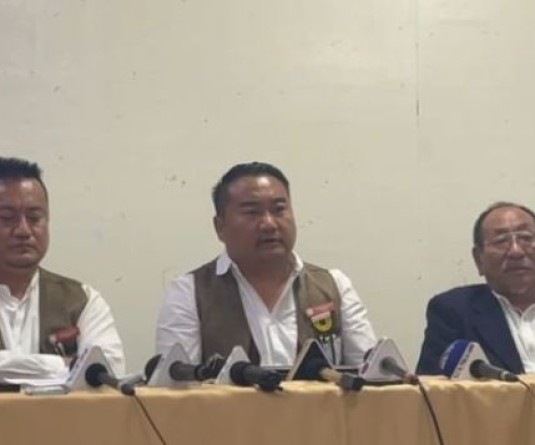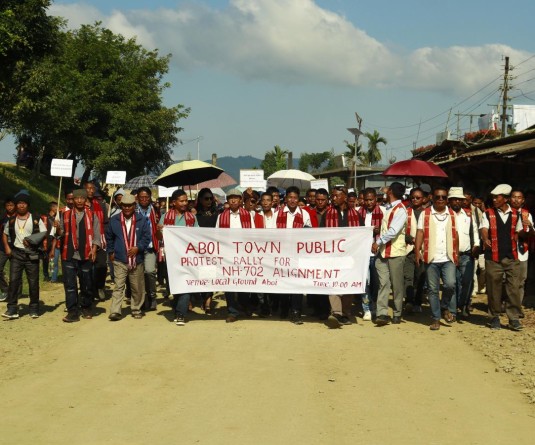Peace Mission members with Nagaland Baptist Church leaders. (File Photo)
Our Correspondent
Chedema | September 6
Narrating the event of Indo-Naga ceasefire, Federal Government of Nagaland (FGN) representative I. Temjenba Longkumer today said the purpose of forming the Nagaland Peace Mission in 1960s was to make the Naga Federal leaders and the leaders of the Government of India come to an understanding over the Indo-Naga conflict thereby restoring it into a normalcy country.
“Therefore, this Peace Day celebration is a reminder of wartime days lest the younger generation forgets to give the life to their roots. This reminder is to caution us to what a war can bring to a country in the absence of peaceful means. I feel obliged to say that we shall be praying for a proper homage to the peace mission members and the church leaders if and when we can resolutely carry on the legacy they had left behind,” Longkumer said during 52nd Indo-Naga ceasefire Day here this morning.
He recalled that on October 1954, the Indian government officially sent their Armed Forces to Tuensang area and declared war against the Nagas, resulting in all over Nagaland.
During the ten years of Indian war against Nagaland the atrocities, and deprivations inflicted on the innocent Naga people by the Indian Armed Forces have caused many lost of lives and wealth.
“No one should ever forget in that ten years of heavy fighting, over a 100,000 of our people perished in cruel hands of Indian Armed Forces. However, by God’s grace the Naga Nation survived,” he said. He said in that tense situation of distress, “our people turn to God for help and the NBCC being deeply concerned for the restoration of peace and normalcy in Nagaland, inspired the church leaders to travel throughout Nagaland in order to bring about peace and normalcy.”
Longkumer said the NBCC decided and held the third Nagaland Baptist Convention at Wokha from 31st January to 2nd February 1964, under the presidentship of Late Toniho Chishi and Imotemjen Aier, secretary who welcomed the proposed “Peace Talks” between the GOI and Late AZ Phizo, president of the Naga National Council. According to official record the Baptist Convention was attended by more than five thousand representatives from all the regions of Nagaland who unanimously resolved to request the GOI to open further avenues for making available, the services of the peace activates late. Rev. G. Michael Scott from Great Britain- who hosted the Naga leader AZ Phizo;
Jayaprakash Narayan, Sarvodaya leader in India and Bimala Prasad Chaliha, a concerned leader for the Nagas who was the then Chief Minister of Assam, with the sole object of exploring ways and means for the speedy restoration of peace and normalcy in Nagaland and that the church leaders of Nagaland are requested to give every possible help and cooperation for the success of the mission.
After the special committee meeting on 13th to 16th March, 1964 at Kohima, the Committee had appointed these three Nagaland Peace Mission members as sponsored by the NBCC namely; late Jayaprakash Narayan, Late BP Chaliha and Late Rev. Michael Scott.
Longkumer said on seeing the noble endeavor of the Nagaland Baptist Church Convention, the service of mediation began with a mass meeting held on Sunday the 5th April 1964 at Kohima and the three peace mission members along with all the prominent church leaders and helpers met successful encounter both from the Government of India and Naga Federal Government.
In the course of time church leaders could have arranged first with the Government of India to relax the Indian Army operation for 8 days in and around of villages to meet the Kedahge ([president) and his colleagues of the FGN. “We met the Rev. G. Michael Scoot; Rev. Longri Ao, Kenneth Kerhuo and Rev. Hesiding K. Lungalang in Tamphu village area, Zeliangrong region on April 15, 1964, in our welcome address we have mention that “The Nagas, as an independent Nation, we shall have full cooperation and friendship with India as far as international affairs are concerned, but we shall not surrender a national sovereignty. It is sacrilege and to barter away our motherland for anything, though grand it might be.” I was one of the representatives from among the six members,” Longkumer said.
He said it took five months to conduct the negotiations to realize the cessation of the hostilities in Nagaland on 6th September 1964. But the first major step that was taken at a large gathering at Sakraba village in Chakhesang Region on 24 and 25 May 1964. More than five thousand people attended the meeting.
He said between the Federal Government of Nagaland representatives and the Nagaland Peace Mission member on 24th May 1964 and the consent signed on the 25th May 1964 at this Sakraba village for Indo-Naga Ceasefire.
When the crowd went back to their villages, there was an evening session with the Federal leaders and JP Narayan had proposed on behalf of the Peace Mission members and church leaders that- “ there should be a complete suspension of military movements throughout Nagaland.”
And from that day, he said, the hectic works of the necessary ceasefire was given an unprecedented stimulation to the church leaders. And true to expectation, a great success of the International trilateral agreement of the ceasefire in Nagaland was achieved.
After completion of the negotiations for the terms of agreement acceptable to both the sides, and it was formally signed on August 10, 1964 by the three Naga Federal representatives on behalf of the Federal Government of Nagaland. And on August 14, 1964 signed by late Vishnu Sahay, Convenor, representatives of the Government of India. The Peace Mission members signed as witness.
Longkumer said after the ceasefire agreement was signed, the Indo-Naga Pace Conference was first held on September 23rd and October 1, 1964 in an official level at Chedema Peace hall and the next peace talk at the Khensa Peace hall near Mokokchung on April 5 and 6, 1965.
When the Peace Mission officially delivered a proposal to the Nagas on December 20, 1964, a Special Tatar Hoho (Parliament) was summoned to be held at Wokha where the top Federal and NNC leaders were present. The three Peace Mission members were invited to explain in detail the purpose of their proposals turn up to participate in the deliberation. After a thorough study of the whole issue, the Tatar Hoho could not accept the proposal of the Peace Mission, because their pursuit of the proposal was to participate in the Indian Union and appeal to India to make it possible to satisfy the aspiration of the Nagas from the position of participation, said Longkumer adding that the Nagas replied in short, the sovereignty of Nagaland cannot be acceded to the aggressor India. And it was learned later that the Government of India did not accept the proposal on technical grounds. Therefore, a Naga delegation lead by the Federal Prime Minister went to New Delhi and met Prime Minister Indira Gandhi as many as six times. The several rounds of talks proved to be inconclusive and it was suspended indefinitely before reaching the desired point of international political dialogue.
In the meantime, JP Narayan was going to Patna in 1964 from Kohima, the News Agency reporter met him, in Calcutta Airport and JP was asked: “Sir, what do you say about the Sovereign state of Nagaland?. And J.P had carefully gave the reply, “sovereign of Nagaland is imminently practicable and negotiable.”
Longkumer said the peace talks broke down, not to be resumed, but the ceasefire continued, being extended at tri-monthly and later monthly intervals formally, through separate announcement by the two sides, meanwhile, ceasefire violation and counter violation took place from the two sides. The Peace Mission dissolved. JP Narayan resigning first; B.P. Chaliha’s resignation followed (his health was failing with his hopes for a settlement). And in May 1966 Rev. G. Michael Scott was arrested in Shillong and deported to England from India. All his papers recording, etc.. etc. were seized, in cruel breach of understanding by which the Peace Mission had been operating.
But after the peace-talks at Khensa the following Peace Observation Team were appointed by the Peace Mission with the approval of the Government of India and the Federal Government of Nagaland. The team shall have authority to investigate any allegation of violation of the agreed terms reported to have occurred after February 24, 1965. It is not expected to investigate the incident occurring before that date. They are: Nabakrushan Choudhury, Dr. M. Aram, Analprabha Das and Majorie Sykes.
Longkumer said later two officers were appointed from the Naga National worker in the Observer Team; namely L. Phanitphang and Col. Aomeri.





